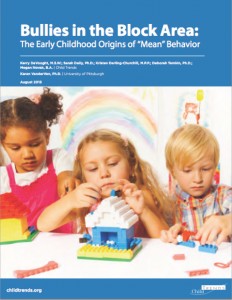
Bullies in the Block Area: The Early Childhood Origins of “Mean” Behavior
 By Kerry DeVooght, M.S.W.; Sarah Daily, Ph.D.; Kristen Darling-Churchill, M.P.P.; Deborah Temkin, Ph.D.; Megan Novak, B.A.; Child Trends Karen VanderVen, Ph.D.,University of Pittsburgh | Published August 2015
By Kerry DeVooght, M.S.W.; Sarah Daily, Ph.D.; Kristen Darling-Churchill, M.P.P.; Deborah Temkin, Ph.D.; Megan Novak, B.A.; Child Trends Karen VanderVen, Ph.D.,University of Pittsburgh | Published August 2015
A familiar scene in preschools nationwide might go something like this:
Jacob and Stella are building an elaborate castle for the family of farm animals they have gathered. Stella is the self-appointed architect and foreman of the construction, while Jacob hands over the materials and cheers Stella on as the towers go precariously skyward. Sam wanders over to admire their project. “Cool!” he says. “Can I help?” He picks up a yellow block and Stella quickly snatches it from his hands. “NO!” she yells. “We don’t want you to help!” “Yeah!” chimes Jacob. “You can’t play with us. Go away!” Sam begins to cry for his teacher as he slowly backs away.
Exclusionary or “mean” behavior in early childhood is no recent or rare phenomenon—in fact, scenarios like the one above are common in preschool classrooms or daycare settings. As children in this age group are still developing basic social skills and conceptions of morality, this type of interaction may be dismissed as “no big deal” or just “kids being kids.” Most people would hesitate to label the young children in the aforementioned scene as “bullies” or “victims,” yet verbal and relational aggression have clearly taken place, and a child has been excluded and rejected. Despite the frequency of these interactions or the rejection inherent in them, little emphasis has been placed on the implications of these early experiences. Further, there has been scarce attention paid to how early warning signs for later bullying may manifest in this age group. The recent increased attention to the harmful effects of bullying for school-aged children and adolescents, however, has led to a heightened awareness of the problem of peer victimization—and a recognition of the importance of identifying and mitigating early childhood risk factors for later bullying. Understanding and addressing the root causes of bullying is profoundly important, given the sometimes devastating consequences to its victims…
To date, little attention has been given to the relationship between early childhood experiences and bullying behaviors later in life. The existing body of research on bullying in older children and youth is critically important, yet the factors that contribute to a child’s engaging in bullying behaviors are likely experienced earlier in life. In fact, studies show that the spontaneous demonstration of bullying behavior among school-aged children is highly unlikely (Nagin & Tremblay, 1999; Broidy, Nagin, Tremblay, Bates, Brame, Dodge, Ferguson, et al., 2003), and the precursors of bullying behavior can be seen already in early childhood (Perren & Alsaker, 2006; Vlachou, Andreou, Botsoglou, & Didaskalou, 2011).
We may be missing an important opportunity to identify and address the antecedents of bullying before these behaviors become organized and intentional (Fraser, Lee, Kupper, & Day, 2010; Storey & Slaby, 2013; Tremblay, et al., 2010).
At least some bullying behavior likely has roots in adverse childhood experiences, such as experiencing or witnessing violence, or neglect by caregivers. Other correlates of bullying may, on the surface, seem less severe than these experiences, yet they can also have a profound, negative effect on a child and increase his or her Bullies in the Block Area 3 likelihood of future involvement in bullying. These may include certain parental personality traits (e.g., lack of warmth or empathy), lack of time spent engaging with caregivers or family members, and exposure to certain media. Empirical evidence documenting the links between experiences in early childhood (defined here as birth to age five) and later bullying has only recently begun to emerge. Further, there are few interventions designed to mitigate or change the course of potential future bullying behavior starting in the early years.
This paper aims to address some of these gaps, by (1) summarizing what is currently known about the developmental trajectory and stability of bullying behavior over the course of a child’s life, (2) identifying the early experiences and factors that provide the strongest evidence for contributing to later bullying behavior, and (3) describing promising strategies and evidence-based intervention models designed to prevent bullying by addressing these factors in early childhood. The material presented here can be used to inform the first iteration of a theoretical model of early bullying behavior and its developmental link to later bullying, as well as next steps for the research, policy, and practitioner communities.
- Read the paper
- See other resources from ChildTrends.org about early prevention of bullying
AUG
2015


About the Author:
Bob Rosenbaum manages the website and other communications functions for Hanna Perkins Center.